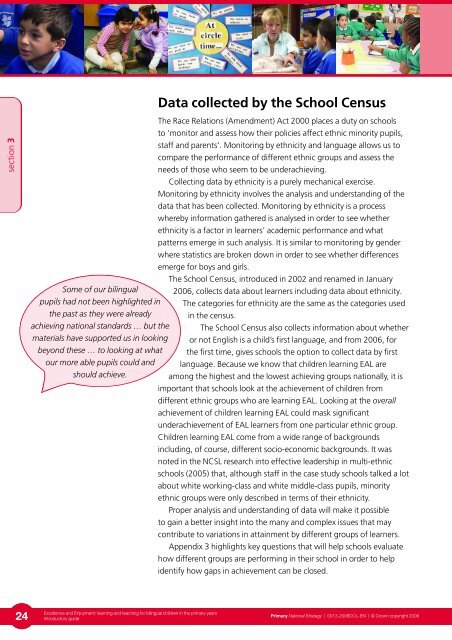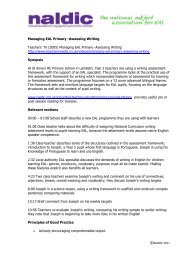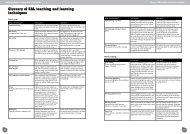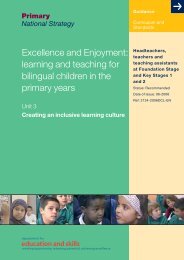Excellence and Enjoyment: learning and teaching for ... - NALDIC
Excellence and Enjoyment: learning and teaching for ... - NALDIC
Excellence and Enjoyment: learning and teaching for ... - NALDIC
You also want an ePaper? Increase the reach of your titles
YUMPU automatically turns print PDFs into web optimized ePapers that Google loves.
Data collected by the School Censussection 3Some of our bilingualpupils had not been highlighted inthe past as they were alreadyachieving national st<strong>and</strong>ards … but thematerials have supported us in lookingbeyond these … to looking at whatour more able pupils could <strong>and</strong>should achieve.The Race Relations (Amendment) Act 2000 places a duty on schoolsto ‘monitor <strong>and</strong> assess how their policies affect ethnic minority pupils,staff <strong>and</strong> parents’. Monitoring by ethnicity <strong>and</strong> language allows us tocompare the per<strong>for</strong>mance of different ethnic groups <strong>and</strong> assess theneeds of those who seem to be underachieving.Collecting data by ethnicity is a purely mechanical exercise.Monitoring by ethnicity involves the analysis <strong>and</strong> underst<strong>and</strong>ing of thedata that has been collected. Monitoring by ethnicity is a processwhereby in<strong>for</strong>mation gathered is analysed in order to see whetherethnicity is a factor in learners’ academic per<strong>for</strong>mance <strong>and</strong> whatpatterns emerge in such analysis. It is similar to monitoring by genderwhere statistics are broken down in order to see whether differencesemerge <strong>for</strong> boys <strong>and</strong> girls.The School Census, introduced in 2002 <strong>and</strong> renamed in January2006, collects data about learners including data about ethnicity.The categories <strong>for</strong> ethnicity are the same as the categories usedin the census.The School Census also collects in<strong>for</strong>mation about whetheror not English is a child’s first language, <strong>and</strong> from 2006, <strong>for</strong>the first time, gives schools the option to collect data by firstlanguage. Because we know that children <strong>learning</strong> EAL areamong the highest <strong>and</strong> the lowest achieving groups nationally, it isimportant that schools look at the achievement of children fromdifferent ethnic groups who are <strong>learning</strong> EAL. Looking at the overallachievement of children <strong>learning</strong> EAL could mask significantunderachievement of EAL learners from one particular ethnic group.Children <strong>learning</strong> EAL come from a wide range of backgroundsincluding, of course, different socio-economic backgrounds. It wasnoted in the NCSL research into effective leadership in multi-ethnicschools (2005) that, although staff in the case study schools talked a lotabout white working-class <strong>and</strong> white middle-class pupils, minorityethnic groups were only described in terms of their ethnicity.Proper analysis <strong>and</strong> underst<strong>and</strong>ing of data will make it possibleto gain a better insight into the many <strong>and</strong> complex issues that maycontribute to variations in attainment by different groups of learners.Appendix 3 highlights key questions that will help schools evaluatehow different groups are per<strong>for</strong>ming in their school in order to helpidentify how gaps in achievement can be closed.24<strong>Excellence</strong> <strong>and</strong> <strong>Enjoyment</strong>: <strong>learning</strong> <strong>and</strong> <strong>teaching</strong> <strong>for</strong> bilingual children in the primary yearsIntroductory guidePrimary National Strategy | 0013-2006DCL-EN | © Crown copyright 2006
















